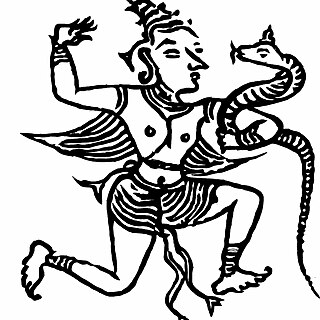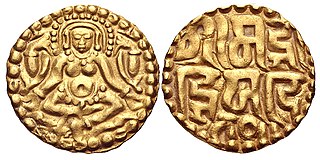Parmar, also known as Panwar or Pawar, is a Rajput clan found in Northern and Central India, especially in Rajasthan, Gujarat, Punjab, Haryana, Uttarakhand, Uttar Pradesh, Bihar, Madhya Pradesh and North Maharashtra. The clan name is also used by Kōḷīs, Garoḍās, Līmaciyā Valands, Mōcīs, Tūrīs, Luhārs, Kansārās, Darajīs, Bhāvasārs, Cūnvāḷiyās, Ghañcīs, Harijans, Sōnīs, Sutārs, Dhobīs, Khavāsas, Rabārīs, Āhīrs, Sandhīs, Pīñjārās, Vāñjhās, Dhūḷadhōyās, Rāvaḷs, Vāgharīs, Bhīls, Āñjaṇās, Mer and Ḍhēḍhs.
The Western Satraps, or Western Kshatrapas were Indo-Scythian (Saka) rulers of the western and central parts of India, between 35 and 415 CE. The Western Satraps were contemporaneous with the Kushans who ruled the northern part of the Indian subcontinent, and were possibly vassals of the Kushans. They were also contemporaneous with the Satavahana (Andhra) who ruled in Central India. They are called "Western Satraps" in modern historiography in order to differentiate them from the "Northern Satraps", who ruled in Punjab and Mathura until the 2nd century CE.

The Kalachuris of Kalyani, also Southern Kalachuris, were a 12th-century Indian dynasty, who ruled over parts of present-day northern Karnataka and Maharashtra. This dynasty rose to power in the Deccan region between 1156 and 1181 CE.

The Traikutakas were a dynasty of Indian kings who ruled between 388 and 456. The name "Traikutakas" seems to be derived from the words for a three-peaked mountain ("Tri-kuta"). The Traikutakas are mentioned in Kalidasa's Raghuvamsa, in which they are located in the area of northern Konkan. The dominions of the Traikutakas further included Aparanta and northern Maharashtra.

The Paramara dynasty was the ruling dynasty of Kingdom of Malwa in west-central India between 9th and 14th centuries. They belonged to the Parmara clan of the Rajputs.
The Ancient history of Mumbai recounts the history of Mumbai from 300 BCE to 1348 CE.
Gavli is a Hindu caste in the Indian states of Maharashtra and Madhya Pradesh. They are a part of the Yadav community.

Ishwarsena was the founder of the Abhira dynasty and he started an era which later became known as the Kalchuri-Chedi era. He and his descendants whose names do not occur in the Puranas seem to have ruled over a large territory comprising Gujarat, Konkan and Western Maharashtra. His descendants ruled for nine generations.
The Abhiras were a legendary people mentioned in ancient Indian epics and scriptures as early as the Vedas. they were a warlike tribe is admitted by all. Probably they were a nomadic people as they are associated with various peoples and provinces. A historical people of the same name are mentioned in the Periplus of the Erythraean Sea. The Mahabharata describes them as living near the seashore and on the bank of the Sarasvati River, near Somnath in Gujarat.

The Kalachuris of Tripuri, also known the Kalachuris of Chedi, ruled parts of central India during 7th to 13th centuries. They are also known as the Later Kalachuris to distinguish them from their earlier namesakes, especially the Kalachuris of Mahishmati. Their core territory included the historical Chedi region, and their capital was located at Tripuri.

The Kalachuri dynasty, also known as Kalachuris of Malwa or Mahismati, or the Early Kalachuris, was the ruling dynasty of the Kingdom of Malwa between 6th and 7th centuries. The territory ruled by them included parts of present-day Gujarat, Madhya Pradesh, and Maharashtra. Their capital was located at Mahishmati. Epigraphic and numismatic evidence suggests that the earliest of the Ellora and Elephanta cave monuments were built during the Kalachuri rule.
The Maharajas of Valkha were part of a central Indian dynasty that ruled the historical Valkha region. They are known from several inscriptions dated to the years 38-134 of an unspecified calendar era. Based on the identification of this era with the Gupta era, they are believed to have ruled during 4th and 5th centuries CE. These rulers of Valkha were probably vassals of the Gupta emperors.
Shankaragana III was a ruler of the Kalachuri dynasty of Tripuri in central India. His kingdom was centered around the Chedi or Dahala region in present-day Madhya Pradesh. He defeated a weak Gurjara-Pratihara ruler, and seems to have died in a battle against the Chandelas.
Yashahkarna was a ruler of the Kalachuri dynasty of Tripuri in central India. His kingdom was centered around the Chedi or Dahala region in present-day Madhya Pradesh.
Gayakarna was a ruler of the Kalachuri dynasty of Tripuri in central India. His kingdom was centered around the Chedi or Dahala region in present-day Madhya Pradesh.
Trailokyamalla, also called Trailokyamalladeva, was a ruler of the Kalachuri dynasty of central India. His kingdom was centered around the Chedi or Dahala region in present-day Madhya Pradesh. Trailokyamalla is the last known king of his dynasty. It is not known how and when his rule ended.
Ratnadeva II was the greatest ruler of the Kalachuri dynasty of Ratnapura, in modern-day Indian state of Chhattisgarh. He is known for declaring independence from their overlords, the Kalachuris of Tripuri and defeated an army sent by the Kalachuri king Gayakarna. He is also known for repulsing an invasion by the mighty king of Kalinga, Anantavarman Chodaganga. His predecessor was Jajalla-deva I, his father and was succeeded by Prithvi-deva II, who was most likely his son.

The Abhira dynasty was a dynasty that ruled over the western Deccan, where it perhaps succeeded the Satavahana dynasty. From 203 CE to roughly 270 or 370, this dynasty formed a vast kingdom. The Abhiras had an extensive empire comprising Maharashtra, Konkan, Gujarat and part of south Madhya Pradesh.
Kokalla I was a ruler of the Kalachuri dynasty of Tripuri in central India. His kingdom was centered around the Chedi or Dahala region in present-day Madhya Pradesh. He appears to have been the first powerful ruler of the dynasty. He consolidated his kingdom and maintained matrimonial relations with the Rashtrakuta empire, and Chandela dynasty.
The Kalachuris of Sarayupara were a medieval Indian dynasty who ruled along the banks of the Sarayu river in present-day Uttar Pradesh. Their domain consisted of the present-day Bahraich and Gonda districts.





